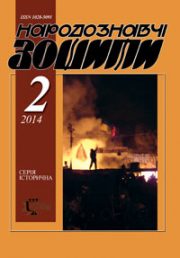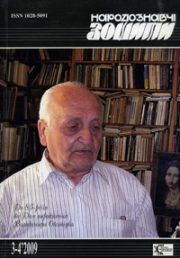The Ethnology Notebooks. 2019, 1 (145), 13—19
UDK 7.031.4:7.036(477) “20”
DOI https://doi.org/10.15407/nz2019.01.013
FOLKLORE CULTURE IS IN THE UKRAINIAN CONTEMPORARY ART
SKLYARENKO Galina
Candidate of Art Studies, Senior Researcher
Institute of Art Studies, Folklore Studies and Ethnology.
M.T. Rilsky National Academy of Sciences of Ukraine,
4, st. Mikhail Hrushevsky, 01011, Kyiv, Ukraine,
Institute for Modern Art Problems
National Academy of Arts of Ukraine
18D,
Eugene Konovalets str., 01133, Kyiv, Ukraine
Contacts: e-mail:galyna2010@ukr.net
Abstract. In the Ukrainian culture a folk art traditionally occupies a considerable and noticeable place, accumulates cultural and national experience. On every historical stage of ХХ of century an address to the folk flows was the means of updating of the Ukrainian art, plastic principles and artistic language on the whole. A contemporary art, that was formed in the years of «perestroika» and grew into the considerable phenomenon of culture in the years of Independence, exposes new senses in a folklore culture, connects it to contemporary artistic practices. Unlike previous periods, when folk traditions attracted artists the formally-aesthetic expressiveness, modern art centrate attention on syncretism of folklore culture, continuity of its imaginative, ritual and functional bases. Interpretation of folk culture and graphic folklore became basis of the newest installations, actions in natural surroundings, projects of land-art, that designated a tendency in the Ukrainian contemporary art, brought new senses to the traditional theme, connected a folklore culture to actual artistic space.
Keywords: contemporary art, a folklore culture, conceptual practices.
Received 24.12.2018
REFERENCES
Bogemskaya, K. (2001). Ponyat primitiv. Samodeyatelnoe, naivnoe i autsajderskoe iskusstvo v XX veke. Sankt-Peterburg: Alteya [in Russian].
Hurenko, A. (2005). Mystetstvo zemli: rizni oblychchia ukrains’koho genius loci. Obrazotvorche mystetstvo, 3, 100—102 [in Ukrainian].
Dziuba, I. (2006). Dopovidi. Retsenzii. Peredmovy. Descho pro dobrykh susidiv i dukhovnu ridniu. In Z krynytsi lit: u tr’okh tomakh (T. 1. Statti). Kyiv: Vyd. dim «Kyievo-Mohylians’ka akademiia» [in Ukrainian].
Lemarshand, F. (2001). Topos Chornobylia (Ch. 78, pp. 374). Kyiv: Dukh i litera [in Ukrainian].
Mystetstvo dovkillia. (2010). Ukraina 1989—2010. Al’bom. Kyiv: Sofiia-A [in Ukrainian].
Picheta, V. (1919). O svyazi mezhdu nekotorymi techeniyami zhivopisi i narodnym iskusstvom. Tvorchestvo: Zhurnal Hudozhestvennogo ceha, 1, 27. Harkov [in Russian].
Prokofev, A. (1989). O treh urovnyah hudozhestvennoj kultury Novogo i Novejshego vremeni. In Primitiv i ego mesto v hudozhestvennoj kulture Novogo i Novejshego vremeni. Moskva: Nauka [in Russian].
Putilov, B.N. (1994). Folklor i narodnaya kultura. Sankt-Peterburg: Nauka [in Russian].
Selivachov, M. (Ed.). (1998). Do typolohii rehresyvnykh i reheneratyvnykh iavysch u narodnomu mystetstvi XX st. In Rehres i reheneratsiia v narodnomu mystetstvi. Kolektyvne doslidzhennia za materalamy tretikh honcharivs’kykh chytan’. Kyiv: Muzej Ivana Honchara; Rodovid [in Ukrainian].






